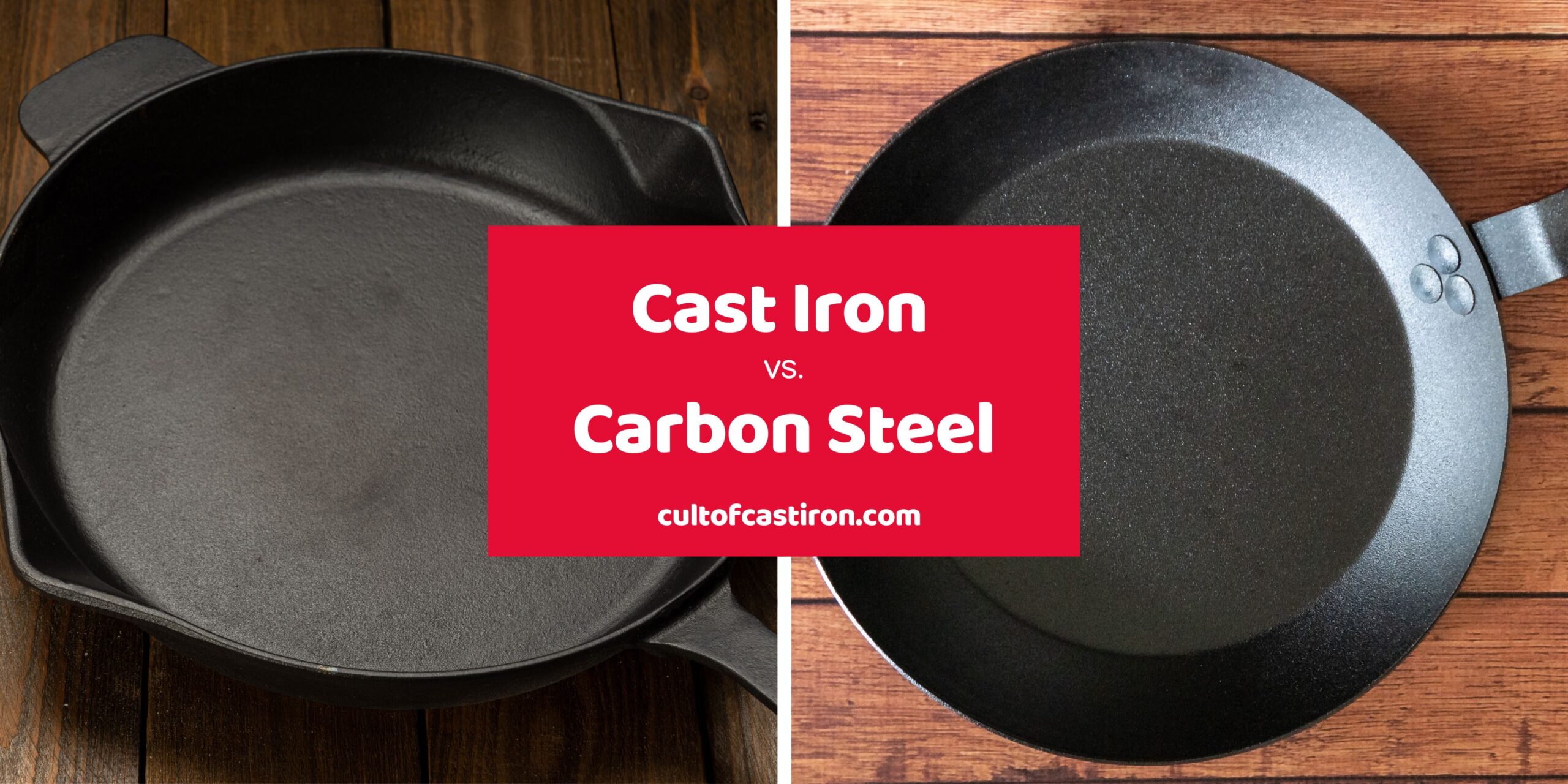When it comes to durable and non-stick cookware, many home cooks often turn to cast iron and carbon steel. These two types of cookware are coated with a polymerized layer of oil called the seasoning, which gives them both non-stick properties and a certain degree of protection against moisture. Ultimately, deciding between these depends on personal preference and specific cooking needs.
The weight is a noticeable distinction in comparing cast iron vs. carbon steel cookware. Cast iron is heavier, while carbon steel provides a lighter alternative. However, their metallurgical differences extend beyond weight and significantly impact their performance in the kitchen.
Both materials have pros and cons, making them suitable for different cooking applications. Understanding the differences between cast iron and carbon steel enables you to make choices that align perfectly with your cooking requirements.
Cast Iron vs. Carbon Steel
In comparing cast iron and carbon steel cookware, you should consider the following criteria:
- Heat conduction and retention
- Heat distribution
- Durability
- Maintenance
- Versatility
- Weight
- Non-stick quality
- Price
Deciding between a trusty cast iron pan and a versatile carbon steel pan is a matter of personal preference and priorities. Consider what matters most and explore this comprehensive cast iron vs. carbon steel guide to discover their differences.
1. Heat conduction and retention
Simply put, cast iron takes a longer time to heat up, but it retains heat better than carbon steel. However, that’s not the whole picture. To better understand this, The table below presents the thermal conductivity values for various metals used in cooking. If the metal is a poor conductor, then it is less responsive to heat. However, it also means that it retains heat for longer.
| Material | Thermal Conductivity (W/mK) |
| Copper | 386 |
| Aluminum | 239 |
| Cast Iron | 55 |
| Carbon Steel | 45 |
| Stainless Steel | 25 |
Metallurgically speaking, carbon steel is a worse conductor of heat than cast iron. This should mean that carbon steel should take a longer time to heat up than cast iron. So, what gives?
Cast iron takes its time to heat up due to its thick walls and base, while carbon steel responds quicker to changes in temperature due to its thinner construction.
The cast iron material has a high capacity for heat retention. It’s ideal for food that requires prolonged cooking durations. With that said, the better responsiveness of carbon steel is more forgiving for newer cooks who are still getting the hang of setting proper cooking temperatures while cooking compare to cast iron.
2. Heat distribution
Since both metals are not great conductors of heat, they also do not distribute heat evenly compared to other types of cookware like aluminum or copper. Both cast iron and carbon steel are prone to developing hot spots while cooking, which makes rotating the pan while a necessity for both to compensate for their poor heat conduction and distribution properties.
With that said, carbon steel ekes out an advantage over cast iron because it is the more thermally-responsive of the two, which makes dealing with hot spots easier.
3. Durability
Cast iron is an absolute powerhouse in terms of durability. Its solid and thick construction compensates for its inherent brittleness which makes it highly resilient. Cast iron cookware is crafted as one solid piece of metal, contributing to its long-lasting nature. The tales of cast iron skillets passed down through generations are extraordinary. It’s amazing to find century-old cast iron cookware still going strong.
On the other hand, carbon steel pans are made by stamping and bolting the handle and body together. While this bolting process introduces the possibility of failure if the bolts corrode, carbon steel is thin yet sturdy.
Despite cast iron’s solid reputation for durability, carbon steel holds its ground with its strength and lightweight design. The secret behind their long-lasting durability lies in the seasoning process.
After each use, a light layer of oil is applied, protecting the cast iron from rust and infusing a deeper flavor into the food. The same principle applies to carbon steel cookware, where a little love and oiling can keep the surface non-stick and resilient for many years of delicious cooking.
4. Maintenance
Both cast iron and carbon steel require a similar level of maintenance. They’re seasoned similarly, which involves applying a thin layer of oil to protect the cooking surface and keep it non-stick. Regular seasoning and proper cleaning are essential to maintain performance and prevent rust. Hence, both score a tie here for being slightly less convenient to use than stainless steel and non-stick pans.
5. Versatility
Cast iron and carbon steel are both superior all-around materials in terms of versatility. You can use them on the stove, in the oven, or over a crackling campfire.
From searing and frying to baking and experimenting with various cooking techniques, cast iron and carbon steel have you covered. So, whether you’re a culinary enthusiast or an outdoor cooking aficionado, you can rely on them to be your trusty companions in the kitchen or out in the wild.
6. Weight
Regarding weight, carbon steel takes the crown for being significantly lighter than cast iron. It’s a breeze to handle and move around in the kitchen. If you prefer easier-to-manage cookware or love stirring and tossing, carbon steel is the way.
On the other hand, cast iron’s heft brings a sense of stability and durability that some cooks appreciate. Ultimately, it all boils down to personal preference and what feels right for your cooking style.
7. Non-stick quality
Carbon steel leads when it comes to non-stick performance. Its naturally smoother cooking surface provides better non-stick qualities compared to cast iron.
While both can be seasoned for improved non-stick properties, carbon steel offers a more immediate and reliable non-stick experience. So if you’re looking for cookware that minimizes sticking and makes cleanup easier, carbon steel is your go-to choice.
8. Price
Carbon steel cookware tends to be pricier than cast iron. The reason behind this price difference lies in the manufacturing process. Crafting carbon steel pans involves more intricate techniques compared to cast iron.
The handles and bodies of carbon steel pans are stamped separately and then bolted together, requiring extra labor and precision. On the other hand, cast iron pans are cast as solid pieces, making their manufacturing process simpler and more cost-effective. Moreover, this easier manufacturing process means that cast iron cookware can come in many different shapes and functions.
Therefore, if you’re on a budget, cast iron cookware might be more wallet-friendly than the slightly higher-priced carbon steel alternatives.
Choose the Perfect Cookware for Your Culinary Adventures
When comparing cookware options, it’s hard not to notice the distinct advantages of cast iron vs. carbon steel. Cast iron offers exceptional heat retention and durability, while carbon steel brings a lighter weight and smooth cooking surface.
Other factors like heat conduction, non-stick quality, versatility, maintenance, and price can also influence your decision. It’s all about finding the perfect balance that suits your cooking needs and preferences.
Explore the Cult of Cast Iron blog for helpful tips and insights on cast iron, carbon steel, stainless steel, copper, and aluminum cookware. Enhance your cooking skills and take your culinary adventures to new heights.

Miguel is a cast iron enthusiast from Cavite, Philippines. He works in the digital marketing field as a content marketing strategist. On the side, he manages a small online bookstore and tends to his plants.


